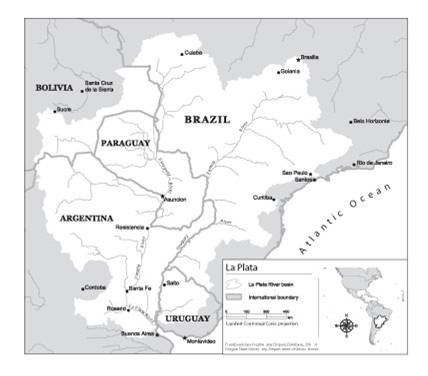International Joint Development of The La Plata River Basin
| Geolocation: | -24° 9' 9.6689", -55° 22' 8.8306" |
|---|---|
| Total Population | 6767,000,000 millionmillion |
| Total Area | 2,954,5002,954,500 km² 1,140,732.45 mi² km2 |
| Climate Descriptors | Moist tropical (Köppen A-type), Humid mid-latitude (Köppen C-type), Moist |
| Predominent Land Use Descriptors | agricultural- cropland and pasture, industrial use, forest land, urban |
| Important Uses of Water | Agriculture or Irrigation, Hydropower Generation, Other Ecological Services |
Contents
Summary
The La Plata River basin encompasses an area of 3.2 million square kilometers and is among the five largest international rivers basins in the world[1] . It includes territory in Argentina, Bolivia, Brazil, Paraguay, and Uruguay, comprises the Parana, Paraguay and Uruguay River systems and makes up the largest wetland in the world-the Pantanal. [2] The Basin's five riparian states have a history of cooperation and joint management of the watershed, and have stressed the river's binding them to each other. The 1969 La Plata River Basin Treaty, the umbrella treaty and first to which all of the riparians are signatories, provides a framework for joint management, development and preservation of the basin. Many bilateral treaties and hydroelectric projects have come out of the 1969 multilateral agreement, however, the first multilateral economic investment that joins all five riparian states and tests the framework of the La Plata Basin Treaty is termed "Hydrovia.'
Hydrovia is the largest project for navigational river development proposed to date. Its size and possible impacts on the economies and environments of the basin states are beginning to strain the cooperative nature of basin management. The biodiversity of the world's largest wetland, the Pantanal, could be strongly affected by the construction of the waterway
The Inter-American Development Bank and the United Nations Development Program, in 1997, helped finance a technical and environmental feasibility study by the Intergovernmental Commission on the Paraná-Paraguay Hydrovia. Through motivation by independent technical critiques and environmental and social action networks the initial studies were discredited. As a result, the future of the Hydrovia is still uncertain. New studies were commissioned by Andean Development Corporation through the Intergovernmental Commission and were completed in February 2004, but the results have yet to be diffused.
Natural, Historic, Economic, Regional, and Political Framework
 Figure 1. Map of the La Plata River Basin [3]
Figure 1. Map of the La Plata River Basin [3]
Background
The La Plata River basin encompasses an area of 3.2 million square kilometers and is among the five largest international rivers basins in the world. It includes territory in Argentina, Bolivia, Brazil, Paraguay, and Uruguay, comprises the Parana, Paraguay and Uruguay River systems and makes up the largest wetland in the world-the Pantanal. The basin is the life sustenance for much of the agricultural and industrial sectors of the riparian states and has become a source of alternative energy and economic possibility.
The Basin's five riparian states have a history of cooperation and joint management of the watershed, and have stressed the river's binding them to each other. Bolivia, Paraguay and Uruguay’s agriculture economies depend on the basin as crucially as the industrial sectors of Argentina and Brazil. Large amounts of grain, beef, wool, timber and some manufacturing goods are exported from this region to other parts of the world. [4] The 1969 La Plata River Basin Treaty, the umbrella treaty and first to which all of the riparians are signatories, provides a framework for joint management, development and preservation of the basin. Subsequent multilateral and bilateral treaties outline the specifics of economic investment, hydro-electric development and transportation enhancement.
Following the 1969 multilateral treaty, bilateral hydroelectric development opportunities were explored which gave source to the construction of dams and alternative power plants along the Parana. Today there are 130 dams along the River, two of which are widely known, the Itaipu and the Yacureta. Itaipu is the largest hydroelectric project in the world and a result of a 1973 bilateral agreement between Paraguay and Brazil. The hydroelectric dam cost the two governments and other international participants US$15 billion and 20 years to construct. The generating capacity is 26,000mW and supplies 26% of all of the electricity for Brazil and 78% for Paraguay with zero emissions.
The political and environmental dimensions of the Itaipu make for an interesting case of cooperation over a shared water resource. The land, where the Itaipu dam now sits, was once a source of great controversy between Brazil and Paraguay. Each country declared rights and legal authority over the Guairá Falls, which lies on the border of both countries and to which both claimed ownership and control. In 1957, Brazil, who believed the Falls to be within their borders and who wanted to invest in the hydroelectric power of the Falls, unilaterally took military control over the region. After five years of dispute and disagreement, Brazil and Paraguay finally negotiated the terms of the Itaipu dam. In addition to providing electricity to the two countries, the proposed project would submerge Guairá Falls [4] thus, marking an end to the border dispute.
This conflict negotiation and cooperation between Brazil and Paraguay had ripple effects into areas of conservation and preservation. When the environmental concerns around the construction of the Itaipu basin came to the forefront, the two countries implemented two joint projects, the Gralha Azul and the Mymba Kuera, to minimize the effects of reservoir flooding on the regions ecology, deforestation in the region and moved the wildlife most affected by the dam to biological reserves. [5]
The Yacyreta Treaty, an agreement between Argentina and Paraguay, to construct a hydroelectric dam downstream from the Itaipu, has not been deemed as successful in its implementation. The treaty was hastily signed in December 1973, very soon after the Itaipu and was similar in content (generated power to be divided evenly between the two nations), except for the Yacyreta allowed for either country to sell power surpluses to a third party. [6] This contingency has since caused great confusion and complicated the construction.
The dam, from its inception, has become a "monument to corruption." The project has been unable to fill the reservoir to planned levels, and is operating at two-thirds of its capacity because of the environmental repercussions the system would incur if it was at 100% capacity. Already, US$1.3 billion worth of non-generated energy has been lost due to delays. In addition, the indigenous populations along the river and beside the dam do not feel like they were part of the planning process, were compensated for losses of their own land or believe they will be allocated power from the hydroelectric plant. At the moment, neither the Paraguayan nor the Argentine governments have the financial resources to allocate for improvements to the construction or to pay remittance to the 4000 families whose lives and environments have been affected by the construction of the dam.
Many bilateral treaties and hydroelectric projects have come out of the 1969 multilateral agreement, however, the first multilateral economic investment that joins all five riparian states and tests the framework of the La Plata Basin Treaty is termed “Hydrovia”. The Hydrovia is a proposed river transportation project that will dredge and straighten major portions of the Paraná and the Paraguay, including the portions of the river that lie in the Pantanal wetlands. The initial backers of the proposal, dubbed "Hydrovia" ("waterway" in Spanish and Portuguese), were the governments of the La Plata basin states who met in 1988 to discuss the plans for the project and out of which was borne the Intergovernmental Commission on the Paraná-Paraguay Hydrovia. The project would allow year-round barge transportation (current conditions only allow for barges during the three dry months) and would open up a major transport thoroughfare for land-locked sections of the riparian states. The proposed waterway would make it possible for barge ships to take the 2000 mile trip from Argentina and Uruguay ports of the Atlantic to landlocked Bolivia and Paraguay [7] Environmentalists and those whose livelihoods depend on traditional economies have expressed trepidation at the project.
The Problem
A cooperative management body has been in place on the La Plata basin since 1969 and is generally considered a successful and productive organization. At the same time, 'Hydrovia' is the largest project for navigational river development proposed to date. Its size and possible impacts on the economies and environments of the basin states are beginning to strain the cooperative nature of basin management. The biodiversity of the world's largest wetland, the Pantanal, could be strongly affected by the construction of the waterway. Covering over 53,760 square miles in Brazil, Paraguay and Bolivia, the Pantanal is home to 650 species of birds, 240 varieties of fish and more than 90,000 types of plants.[8] Opponents of the project point to loss of biodiversity and significant changes in the hydrology of the Pantanal as reasons why the project should be avoided. The Pantanal currently decreases the occurrence of floods and droughts in the downstream area [9], maintains the current ecosystem and hydrology there and is the life sustenance of the people, animals and wildlife along its banks.
Attempts at Conflict Management
The La Plata Basin Treaty of 1969 provides an umbrella framework for several bilateral treaties between the riparian states and a direction for joint development of the basin. The treaty requires open transportation and communication along the river and its tributaries, and prescribes cooperation in education, health, and management of 'non-water' resources (e.g., soil, forest, flora, and fauna). The foreign ministers of the riparian states provide the policy direction, and a standing Intergovernmental Coordination Committee is responsible for ongoing administration. Basin states agree to identify and prioritize cooperative projects, and to provide the technical and legal structure to see to their implementation, illustrated best by the 130 dams along the Parana, the construction of the world's largest hydroelectric project, Itaipu, and successive development, infrastructure and transportation projects. The treaty also has some limitations, notably the lack of a supra-legal body to manage the treaty's provisions. The necessity to go through each country's legal system for individual projects has resulted in some time lag and lack of implementation. The 1969 treaty's success has been in the areas of transportation and cooperation, so it is not altogether surprising that the 'Hydrovia' project has been forwarded to the planning stages and that many multilateral and bilateral treaties came out of the 1969 La Plata Basin Treaty. The first meeting of the backers of the project was in April of 1988, out of which the Intergovernmental Commission on the Paraná-Paraguay Hydrovia was formed.
Outcome
As positions between supporters and opponents of the project have sharpened, these positions are based on very little information. The Inter-American Development Bank and the United Nations Development Program, in 1997, helped finance a technical and environmental feasibility study by the Intergovernmental Commission on the Paraná-Paraguay Hydrovia. The study included dredging, rock removal and structural channeling. Through motivation by independent technical critiques and environmental and social action networks the initial studies were discredited. As a result, the future of the Hydrovia is still uncertain. New studies were commissioned by Andean Development Corporation through the Intergovernmental Commission and were completed in February 2004, but the results have yet to be diffused.
Issues and Stakeholders
Promoting and coordinating the joint development of the La Plata basin.
NSPD: Water Quantity, Ecosystems, Governance, Assets
Stakeholder Types: Sovereign state/national/federal government, Non-legislative governmental agency, Environmental interest, Industry/Corporate Interest
The La Plata Basin Treaty has helped bring the five nations together and aid in not their own disputes, but assist in resolving disputes between sectors. The nations cooperate well, and the treaty has been helpful to resolve intersectorial conflicts.
Stakeholders:
- Argentina
- Bolivia
- Brazil
- Paraguay
- Uruguay
- Intergovernmental Coordinating Committee
- Inter-American Development Bank
- United Nations Development Program
- Andean Development Corporation
Analysis, Synthesis, and Insight
Individuals may add their own Analysis, Synthesis, and Insight (ASI) to a case. ASI sub-articles are protected, so that each contributor retains authorship and control of their own content. Edit the case to add your own ASI.
Learn moreASI:Lessons learned for cooperation between riparians and sectors
Contributed by: Aaron T. Wolf, Joshua T. Newton, Matthew Pritchard (last edit: 12 February 2013)
Key Questions
Transboundary Water Issues: What mechanisms beyond simple allocation can be incorporated into transboundary water agreements to add value and facilitate resolution?
If riparian states start cooperation from the outset of a conflict, instead of letting it create stronger positions, the economic and joint management prospects are much greater. Since 1969, the quantity of joint economic ventures in the La Plata Basin has allowed for increased cooperation between the riparian nations when many times conflict could have arisen and defeated the benefits the states are receiving today.
Influence Leadership and Power: How does asymmetry of power influence water negotiations and how can the negative effects be mitigated?
If riparian states agree to equal access to transboundary water resources, equal and joint management, investment and distribution of that resource is feasible. In the water resources sector, neither Brazil nor Argentina has used their economic or military superiority to maintain greater control over water resources or hydroelectric potential.
External Links
- Transboundary Freshwater Dispute Database (TFDD) (2012). Oregon State University. — This website is used to aid in the assessment of the process of water conflict prevention and resolution. Over the years we have developed this Transboundary Freshwater Dispute Database, a project of the Oregon State University Department of Geosciences, in collaboration with the Northwest Alliance for Computational Science and Engineering.
- ^ United Nations. (1978). Register of international rivers, Water Supply Management, 2 (1). New York: Pergamon Press.
- ^ Gleick, P.H., ed. (1993). Water in Crisis. A Guide to the World's Fresh Water Resources, New York : Oxford University Press, pp. 13-24.
- ^ Product of the Transboundary Freshwater Dispute Database, Department of Geosciences, Oregon State University. Additional information about the TFDD can be found at: http://www.transboundarywaters.orst.edu
- ^ 4.0 4.1 Elhance, A. P. (1999). Hydropolitics in the 3rd World, Conflict and Cooperation in International River Basins. Washington DC: United States Institute of Peace.
- ^ American University Trade and Environment data base (2004). Itaipu Dam. Available online at http://www.american.edu/TED/itaipu.htm.
- ^ Da Rosa, J. E. (1983). Economics, politics, and hydroelectric power: the Parana River Basin. Latin American Research Review, VXVIII (3), pp. 77-107
- ^ American University Trade and Environment data base. (1999). Hydrovia Canal Plan and Environment. Available online at http://www.american.edu/TED/hidrovia.htm
- ^ Bascheck, B. and Hegglin, M. (2004). Plata/Parana River Basin, A Case Study. Swiss Federal Institute for Environmental Science and Technology.
- ^ Lammers, O., Moore, D. and Preakle, K. (1994). Considering the Hidrovia: a preliminary report on the status of the proposed Paraguay/Parana waterway project. Working Paper 3. Berkley CA: International Rivers Network, July.



